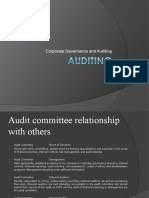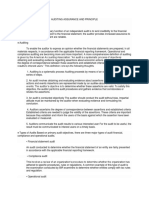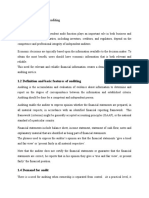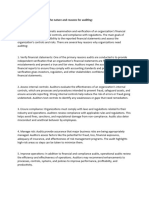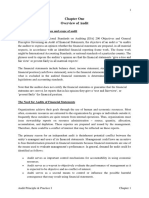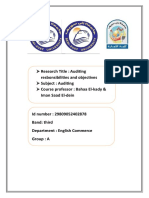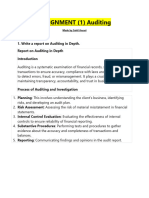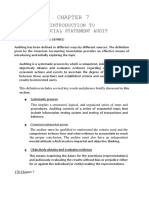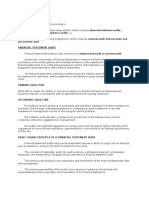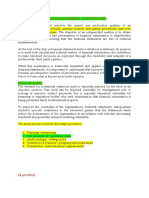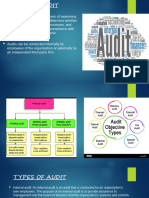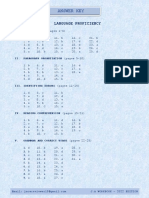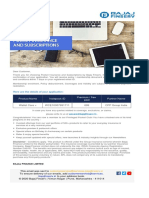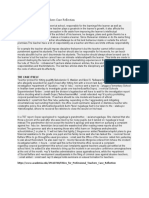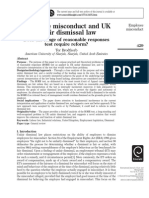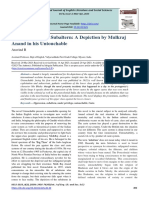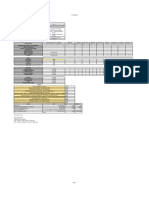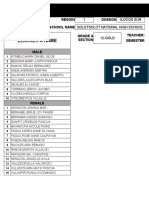3 Types of Auditors
Uploaded by
Jaymark D3 Types of Auditors
Uploaded by
Jaymark D3 TYPES OF AUDITORS
1. Independent auditor is a practicing CPA hired by a business entity to perform an examination of its financial
statements and to express an opinion on its fair presentation
2. Internal auditor is a Certified Public Accountant who performs independent appraisal within the business
organization
3. Government auditor is a Certified Public Accountant employed by government agencies, such as the
Commission on Audit (COA) that performs examination of governmental units, public entities and private
organizations using public funds; and the Bureau of Internal Revenue (BIR) that performs examination of
financial statements to determine taxpayers’ compliance with tax laws.
THE SOCIAL CONCEPT OF AN AUDIT AND ITS CHANGING ROLE
In the 19th century auditing or the verification of records was performed by the bookkeepers
The functions of auditing can no longer be contained around the desks provided by clients to the practitioner
performing fieldwork for an audit engagement.
Audits have since evolved from attestation engagements to assurance and non-assurance services
3 GENERAL TYPES OF AUDIT
1. Financial Statement Audit A financial statement audit is better known as an independent, external audit,
whose practice is outside the client’s organization.
The objectives of a financial statement audit are to enable the auditor to express an opinion on its fair
presentation in accordance with generally accepted accounting principles:
Specifies the period covered by the auditor’s examination, the scope or audit procedures deemed necessary
under the circumstances to achieve the objective of the audit, and the use of audit procedures applied on a
test basis on evidence
Offers decision-makers a reliable basis for the choice or course to take to achieve organization’s goals.
A financial statement audit supplements an individual’s innate honesty, as a fraud deterrent to officers and
employees and as an incentive for the exercise of greater than due care in performing assigned tasks.
2. Internal Audit is a managerial control that measures and evaluates the effectiveness of other controls. It is
an independent appraisal activity within an organization for the review of operations as a service to
management.
objective of internal auditing is to assist all members of management in the effective discharge of their
responsibilities by furnishing them with analyses, appraisals, recommendations and comments concerning
the activities reviewed.
Should have free access to all records, properties and personnel of the organization, whenever necessary in
the performance of his functions.
Responsibility may be classified into activities that involve financial and operational or management
auditing.
The internal auditor must be independent of the organization’s management and personnel. He shows his
independence and objectivity by not engaging in activities, which he himself will later appraise.
External audits are conducted by independent auditors for the purpose of gathering evidence on which to
base an opinion on the fair presentation of the financial statements of the organization, whereas internal
audits are primarily performed to assist in all phases of managerial functions. Internal auditors are more
directly concerned with the detection and prevention of fraud.
The internal auditor and the external auditor are not competitors, the latter may rely on the work of the
former under certain circumstances.
3. Government Audit is the analytical and systematic examination and verification of financial transactions,
operations, accounts and reports of any government agency to determine their accuracy, integrity and
authenticity, and compliance with the requirements of law, rules and regulations.
Involves the determination of whether government funds are being used properly and in compliance with
existing laws and whether the programs and activities are being conducted efficiently and economically.
The scope of government auditing covers compliance audit, financial audit, and performance audit.
Compliance audit is the examination and settlement in accordance with law and regulation.
Financial audit examines the accounting and financial system and contents to ensure reliability of the
recorded financial data for the purpose of expressing an opinion on the fairness with which the financial
condition and results of operations are presented.
Performance audit is an objective examination of the financial and operational performance of an
organization, program, activity or function to determine opportunities for greater economy, efficiency and
effectiveness.
A management audit is the appraisal of management performance from the point of view of the least cost
and the analysis of benefits attained against costs incurred.
A program results audit or effectiveness audit is the evaluation of program results in achieving
management goals and objectives.
An economy and efficiency audit determines the causes of inefficiencies or uneconomical practices.
3 MAJOR STEPS IN THE SYSTEMATIC PROCESS
1. Pre-engagement and audit planning activities
2. Gathering and evaluating of evidence
3. Completing the audit and issuing the audit report
TYPES OF TESTS
COMPLIANCE TESTS are tests of controls aimed to determine proper execution, recording and
custodianship in the basic transaction cycles: the revenue and collection cycle, expenditure cycle and
financing and investing cycle.
SUBSTANTIVE TESTS involve the tests of transactions, test of details of balances and analytical procedures.
Substantive tests aim to confirm and substantiate existence or occurrence, completeness, valuation, rights
and obligations, and presentation and disclosure of items in the financial statements.
TYPES OF OPINIONS AND SITUATIONS LEADING TO THEIR EXPRESSION
UNQUALIFIED OPINION expresses ‘present fairly’ when the audit examination was conducted without
restrictions; there are no errors or irregularities that will result to materially misstated financial statements,
no uncertainties exist, disclosures are adequate, and presentation of financial statements is in conformity
with generally accepted accounting principles.
QUALIFIED OPINION expresses ‘present fairly except for’ or ‘subject to’ when the auditor is precluded from
expressing an unqualified opinion because of existing uncertainties or inconsistencies and not very material
departure from generally accepted accounting principles, or failure to apply generally accepted auditing
standards, although not very material.
ADVERSE OPINION states that the financial statements are not fair presentations, that they are not in
conformity with generally accepted accounting principles, when the auditor’s examination revealed very
material departure from generally accepted accounting principles and the auditor was not able to convince
the client to make necessary adjustments or include material disclosures.
DISCLAIMER OF OPINION states that the auditor is not in a position to express an opinion, so no opinion is
expressed on the financial statements, when there have been very material restrictions or limitations to the
conduct of the audit examination and very material uncertainties exist regarding the financial statements.
PIECEMEAL OPINION is an opinion that specifies an identified account or accounts in the financial
statements when the auditor has already expressed a disclaimer or an adverse opinion on the financial
statements taken as a whole. A piecemeal opinion contradicts the disclaimer or adverse opinion and must
be avoided under any circumstances.
Characteristics of an Internal Audit Report
a. scope and purpose of the audit
b. description of the operation or activity audited
c. audit standards complied with
d. audit results or deficiencies discovered, and
e. recommendations for remedial or corrective action
Internal Auditing Approach and Techniques
a. appraisal of controls to determine that adequate operating controls are applied
b. activities to ensure the protection of assets by compliance with established policies, plans and procedures,
accounting and safeguarding company assets:
c. verification of internal management reports by ascertaining reliability of management
d. appraisal of management performance by evaluating the quality of performance of assigned responsibilities;
and
e. recommendations for operational improvements.
Commission on Audit (COA), with jurisdiction and authority defined by the Constitution of the Philippines, is the
highest and final authority in the audit of the government and its instrumentalities;
Principal Duties of the COA
a. To examine, audit and settle all accounts pertaining to the revenue or receipts and expenditures or uses of
government funds and property
b. To keep the general accounts and preserve vouchers pertaining thereof
c. To promulgate accounting and auditing rules and regulations, including those for the prevention of
irregularities, unnecessary, excessive or extravagant expenditures, or uses of funds and property d.
d. To submit to the President of the Philippines within the time fixed by law, an annual financial report of the
government, its subdivisions, agencies and instrumentality, including government-owned or controlled
corporations and recommend measures .
e. To improve their efficiency and effectiveness. To decide cases brought before it within sixty days from the
date of submission for resolution, and f.
f. To perform such other duties and functions, as may be prescribed by law
Functions of Government Auditors
a. To formulate accounting rules and regulations for their respective audit offices
b. To formulate and develop plans, programs, operating standards, and administrative techniques for the
implementation of auditing rules and regulations in their respective audit offices
c. To advise and assist the Chairman of the COA on matters pertaining to the audit of the offices under their
respective jurisdiction
You might also like
- Module #02 - Audits of Historical Financial InformationNo ratings yetModule #02 - Audits of Historical Financial Information3 pages
- SY 2023-2024 Module 1 - Introduction (1)No ratings yetSY 2023-2024 Module 1 - Introduction (1)6 pages
- Introduction To Auditing: 1.1 DefinitionNo ratings yetIntroduction To Auditing: 1.1 Definition14 pages
- ACT 05210 PRINCIPLES OF AUDITING -Kasinga_091926No ratings yetACT 05210 PRINCIPLES OF AUDITING -Kasinga_09192650 pages
- Course: Auditing (481) Semester: Spring 2021 Assignment No.1 Q. 1 Define Auditing and Describe Its Various Techniques? AnswerNo ratings yetCourse: Auditing (481) Semester: Spring 2021 Assignment No.1 Q. 1 Define Auditing and Describe Its Various Techniques? Answer20 pages
- Statistical Method in Professional AuditingNo ratings yetStatistical Method in Professional Auditing34 pages
- Introduction To Auditing: Reference: Chapter Two of Audit and Assurance PrincipleNo ratings yetIntroduction To Auditing: Reference: Chapter Two of Audit and Assurance Principle25 pages
- AUDIT1. 4 The Audit Process Accepting An EngagementNo ratings yetAUDIT1. 4 The Audit Process Accepting An Engagement32 pages
- Auditing Resbonsibilities and Objectives: Research Title: Subject: Auditing Course Professor: Bahaa El-Kady &No ratings yetAuditing Resbonsibilities and Objectives: Research Title: Subject: Auditing Course Professor: Bahaa El-Kady &18 pages
- Auditing Resbonsibilities and Objectives: Research Title: Subject: Auditing Course Professor: Bahaa El-Kady &No ratings yetAuditing Resbonsibilities and Objectives: Research Title: Subject: Auditing Course Professor: Bahaa El-Kady &18 pages
- [Principles and Practice of Auditing] (1)No ratings yet[Principles and Practice of Auditing] (1)4 pages
- Module 1 - Basic Concepts of Financial Statement AuditNo ratings yetModule 1 - Basic Concepts of Financial Statement Audit8 pages
- Auditing:-: Scope and Objective of AuditNo ratings yetAuditing:-: Scope and Objective of Audit31 pages
- Amlyan Mukherjee 23451422005 BBA AT&A Auditing & AssuranceNo ratings yetAmlyan Mukherjee 23451422005 BBA AT&A Auditing & Assurance6 pages
- Audit in Nursing Management and AdministrationNo ratings yetAudit in Nursing Management and Administration31 pages
- India - Changing Face of Serving Summons - From Post To What's App - LexologyNo ratings yetIndia - Changing Face of Serving Summons - From Post To What's App - Lexology3 pages
- 400051_8518511072384_20241020_75680_SOSWKNo ratings yet400051_8518511072384_20241020_75680_SOSWK1 page
- Download Complete The Cryptocurrency Scalping Playbook The Most Profitable Cryptocurrency Scalping and Day Trading Strategies that Work in 2023 Dennis O'Niell PDF for All Chapters100% (2)Download Complete The Cryptocurrency Scalping Playbook The Most Profitable Cryptocurrency Scalping and Day Trading Strategies that Work in 2023 Dennis O'Niell PDF for All Chapters14 pages
- Complete Download Successful Local Anesthesia For Restorative Dentistry and Endodontics Al Reader John Nusstein & Melissa Drum PDF All ChaptersNo ratings yetComplete Download Successful Local Anesthesia For Restorative Dentistry and Endodontics Al Reader John Nusstein & Melissa Drum PDF All Chapters34 pages
- Generic LOA-PEME-ROYAL CARIBBEAN CRUISES LTD.No ratings yetGeneric LOA-PEME-ROYAL CARIBBEAN CRUISES LTD.1 page
- Application For Certificate of Occupancy: (Given Name) (Middle Initial)No ratings yetApplication For Certificate of Occupancy: (Given Name) (Middle Initial)1 page
- Ethics For Professional Teachers Case ReflectionNo ratings yetEthics For Professional Teachers Case Reflection1 page
- Grade 1 (1st Quarter) With Automated MPSNo ratings yetGrade 1 (1st Quarter) With Automated MPS23 pages
- Aesthetic Labour: Rethinking Beauty Politics in Neoliberalism 1st Edition Ana Sofia Elias 2024 scribd download100% (1)Aesthetic Labour: Rethinking Beauty Politics in Neoliberalism 1st Edition Ana Sofia Elias 2024 scribd download65 pages
- Employee Misconduct and UK Unfair Dismissal Law Does The Range of Reasonable Responses Test Require ReformNo ratings yetEmployee Misconduct and UK Unfair Dismissal Law Does The Range of Reasonable Responses Test Require Reform22 pages
- Oppression of The Subaltern: A Depiction by Mulkraj Anand in His UntouchableNo ratings yetOppression of The Subaltern: A Depiction by Mulkraj Anand in His Untouchable3 pages
- Meesan Logistics - FIRE Quote - ICICI LombardNo ratings yetMeesan Logistics - FIRE Quote - ICICI Lombard1 page
- Expanded Syllabus Civil Procedure Remedial Law 2020100% (6)Expanded Syllabus Civil Procedure Remedial Law 2020268 pages
- Math 3 DLP 12 - Addition of Numbers With Regroupng in Short FormNo ratings yetMath 3 DLP 12 - Addition of Numbers With Regroupng in Short Form11 pages
- Input Data Sheet For SHS E-Class RecordNo ratings yetInput Data Sheet For SHS E-Class Record32 pages
- Module #02 - Audits of Historical Financial InformationModule #02 - Audits of Historical Financial Information
- Course: Auditing (481) Semester: Spring 2021 Assignment No.1 Q. 1 Define Auditing and Describe Its Various Techniques? AnswerCourse: Auditing (481) Semester: Spring 2021 Assignment No.1 Q. 1 Define Auditing and Describe Its Various Techniques? Answer
- Introduction To Auditing: Reference: Chapter Two of Audit and Assurance PrincipleIntroduction To Auditing: Reference: Chapter Two of Audit and Assurance Principle
- AUDIT1. 4 The Audit Process Accepting An EngagementAUDIT1. 4 The Audit Process Accepting An Engagement
- Auditing Resbonsibilities and Objectives: Research Title: Subject: Auditing Course Professor: Bahaa El-Kady &Auditing Resbonsibilities and Objectives: Research Title: Subject: Auditing Course Professor: Bahaa El-Kady &
- Auditing Resbonsibilities and Objectives: Research Title: Subject: Auditing Course Professor: Bahaa El-Kady &Auditing Resbonsibilities and Objectives: Research Title: Subject: Auditing Course Professor: Bahaa El-Kady &
- Module 1 - Basic Concepts of Financial Statement AuditModule 1 - Basic Concepts of Financial Statement Audit
- Amlyan Mukherjee 23451422005 BBA AT&A Auditing & AssuranceAmlyan Mukherjee 23451422005 BBA AT&A Auditing & Assurance
- India - Changing Face of Serving Summons - From Post To What's App - LexologyIndia - Changing Face of Serving Summons - From Post To What's App - Lexology
- Download Complete The Cryptocurrency Scalping Playbook The Most Profitable Cryptocurrency Scalping and Day Trading Strategies that Work in 2023 Dennis O'Niell PDF for All ChaptersDownload Complete The Cryptocurrency Scalping Playbook The Most Profitable Cryptocurrency Scalping and Day Trading Strategies that Work in 2023 Dennis O'Niell PDF for All Chapters
- Complete Download Successful Local Anesthesia For Restorative Dentistry and Endodontics Al Reader John Nusstein & Melissa Drum PDF All ChaptersComplete Download Successful Local Anesthesia For Restorative Dentistry and Endodontics Al Reader John Nusstein & Melissa Drum PDF All Chapters
- Application For Certificate of Occupancy: (Given Name) (Middle Initial)Application For Certificate of Occupancy: (Given Name) (Middle Initial)
- Aesthetic Labour: Rethinking Beauty Politics in Neoliberalism 1st Edition Ana Sofia Elias 2024 scribd downloadAesthetic Labour: Rethinking Beauty Politics in Neoliberalism 1st Edition Ana Sofia Elias 2024 scribd download
- Employee Misconduct and UK Unfair Dismissal Law Does The Range of Reasonable Responses Test Require ReformEmployee Misconduct and UK Unfair Dismissal Law Does The Range of Reasonable Responses Test Require Reform
- Oppression of The Subaltern: A Depiction by Mulkraj Anand in His UntouchableOppression of The Subaltern: A Depiction by Mulkraj Anand in His Untouchable
- Expanded Syllabus Civil Procedure Remedial Law 2020Expanded Syllabus Civil Procedure Remedial Law 2020
- Math 3 DLP 12 - Addition of Numbers With Regroupng in Short FormMath 3 DLP 12 - Addition of Numbers With Regroupng in Short Form















